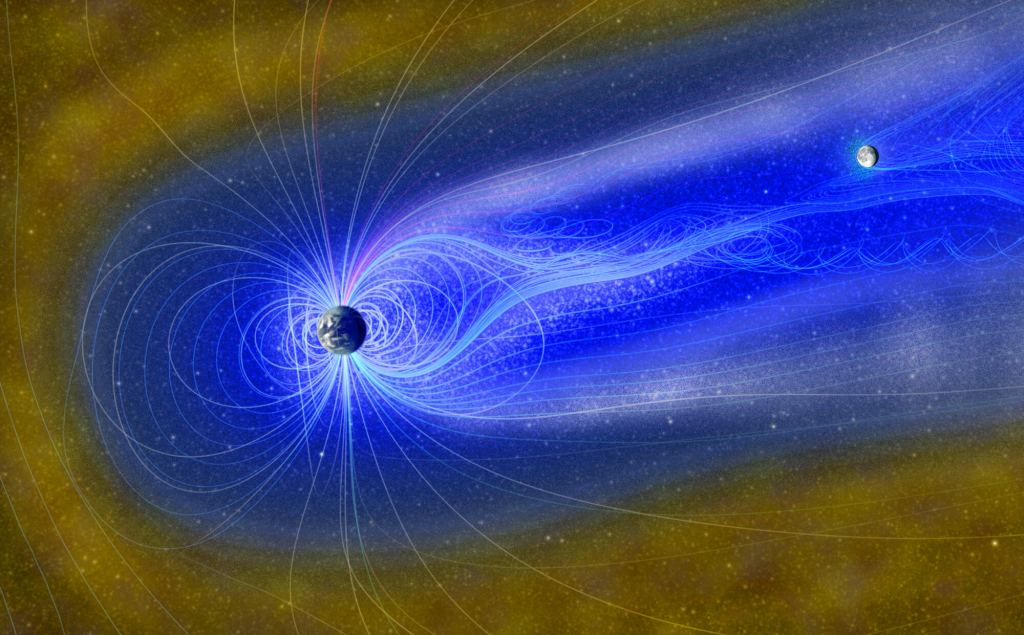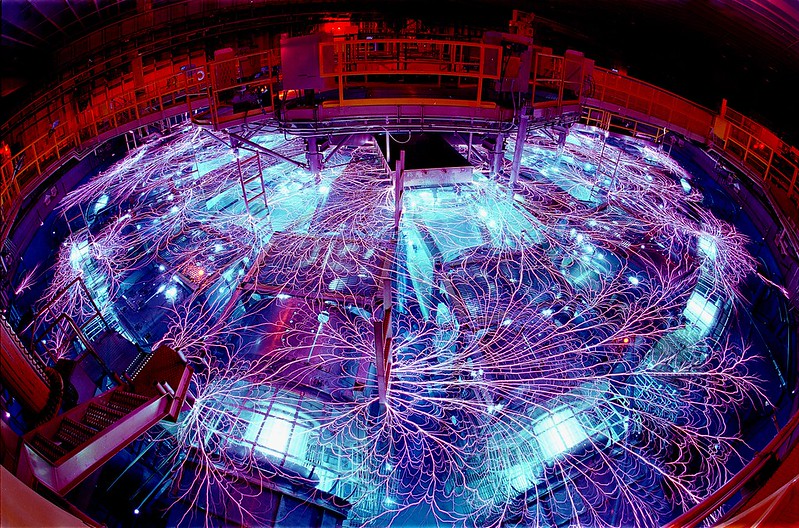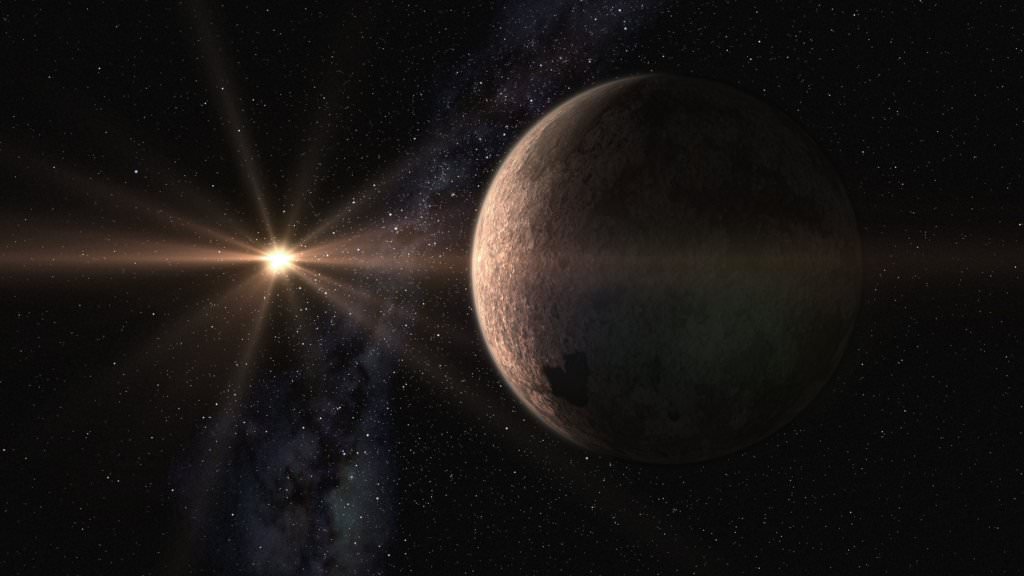Deep inside planet Earth, there is a liquid outer core and a solid inner core that counter-rotate with each other. This creates the dynamo effect that is responsible for generating Earth’s planetary magnetic field. Also known as a magnetosphere, this field keeps our climate stable by preventing Earth’s atmosphere from being lost to space. So when studying rocky exoplanets, scientists naturally wonder if they too have magnetospheres.
Unfortunately, until we can measure an exoplanet’s magnetic fields, we are forced to infer their existence from the available evidence. This is precisely what researchers at the Sandia National Laboratories did with its Z Pulsed Power Facility (PPF). Along with their partners at the Carnegie Institution for Science, they were able to replicate the gravitational pressures of “Super-Earths” to see if they could generate magnetic fields.
The research team was led by Yingwei Fei, a geochemist with Carnegie’s Earth and Planets Laboratory (EPL), and Christopher T. Seagle, a postdoc fellow and manager at the Sandia National Laboratories (SNL). He was joined by multiple researchers from the EPL and SNL. Their findings were presented in a study that was recently published in Nature Communications.

When it comes to gauging planetary habitability, scientists are forced to take what is known as the “low hanging fruit” approach. This means searching for planets that are Earth-like, which essentially means rocky planets with dense atmospheres composed of nitrogen, oxygen, carbon dioxide, methane, and other gases. Another key consideration is whether or not a planet orbits within its parent star’s habitable zone (HZ).
Planets that orbit within this range will experience temperatures warm enough to maintain liquid water on their surfaces. However, as scientists have noted in recent years, geological activity is also a major factor in maintaining Earth’s habitability. As Richard Carlson, Director of the Earth and Planets Laboratory, explained in a Carnegie Science press release:
“Although observations of an exoplanet’s atmospheric composition will be the first way to search for signatures of life beyond Earth, many aspects of a planet’s surface habitability are influenced by what’s happening beneath the planet’s surface, and that’s where Carnegie researcher’s longstanding expertise in the properties of rocky materials under extreme temperatures and pressures comes in.”
In recent years, exoplanet surveys have resulted in the discovery of no less than 4,341 exoplanets in 3216 systems (with another 5,742 candidates awaiting confirmation). Of those confirmed, a robust 1340 have been identified as rocky planets that are many times the mass of Earth and up to 8 times the size – hence the designation “Super-Earth.”

“The ability to make these measurements is crucial to developing reliable models of the internal structure of super-Earths up to eight times our planet’s mass,” Fei added. “These results will make a profound impact on our ability to interpret observational data.”
“The question before us is whether any of these super planets are actually Earthlike, with active geological processes, atmospheres, and magnetic fields,” said Joshua Townsend, a Sandia physicist and co-author on the paper in a recent SNL press release. In other words, are these exotic and massive rocky planets capable of supporting life as we know it?
Located in the heart of the Sandia National Laboratories in Albuquerque, New Mexico, the Z PPF relies on special instruments – like the multi-anvil apparatus, the piston cylinder, and the diamond anvil cell – to simulate the high pressure and temperature conditions in a planet’s interior. In so doing, they are able to measure the physical properties of exoplanets and mimic their gravitational environments.
For the sake of their study, the Carnegie/SNL team replicated the gravitational pressures of “Super-Earths” by applying the equivalent of huge gravitational pressures to bridgmanite (aka. magnesium-silicate) in a near-instantaneous manner. This mineral is the most abundant material in the interior of rocky planets and was used to simulate the mantle material of a super-Earth.

By subjecting the bridgmanite to hypervelocity shockwaves generated by the Z machine, the team was able to recreate pressures representative of a super-Earth interior. Under these conditions, the team found that bridgmanite has a very high melting point, a finding that could have serious implications for the interior dynamics of super-Earths.
As they indicated in their study, under certain thermal evolutionary scenarios, massive rocky planets might develop a thermally-driven geodynamo early in their evolution. However, this dynamo effect may disappear when the cooling of the planet’s interior slows down, only to be re-started due to the movement of lighter elements and the crystallization of the inner core.
The experiments also allowed for the creation of a data table that showed how the state of a planet’s interior (solid, liquid, or gaseous) will vary based on pressure, temperature, and density conditions (and for how long). As Fei explained via SNL’s release:
“In order to build models that allow us to understand the interior dynamics and structure of super-Earths, we need to be able to take data from samples that approximate the conditions that would be found there, which could exceed 14 million times atmospheric pressure. However, we kept running up against limitations when it came to creating these conditions in the lab.”

“Z has provided our collaboration a unique tool that no other technique can match, for us to explore the extreme conditions of super-Earths’ interiors,” he added, via Carnegie Science’s release. “The machine’s unprecedented high-quality data have been critical for advancing our knowledge of super-Earths.”
Based on their analysis of the state of super-Earth interiors, the team also produced a list of seven planets possibly worthy of further study. These include 55 Cancri e, Kepler-10 b, Kepler-36 b, Kepler-80 e, Kepler-93 b, CoRoT-7 b, and HD-219134 b. As Seagle, who initially proposed these experiments with Fei, said:
“These planets, which we found most likely to support life, were selected for further study because they have similar ratios to Earth in their iron, silicates and volatile gasses, in addition to interior temperatures conducive to maintaining magnetic fields for protection against solar wind.”
Super-Earths have become a focal point of interest because their greater size and mass means that they exert large gravitational pressures. As a result, these planets are likely to hold onto their atmospheres for longer periods of time, ensuring that life has a better chance of emerging and evolving to a greater state of complexity.

Their considerable mass also means that pressure and temperature conditions in their interiors are more likely to result in a geodynamo. As Townsend explained, the contrast between Earth and Mars illustrates how this works. “Because Mars was smaller, it had a weaker gravitational field to begin with,” he said. “Then as its core quickly cooled, it lost its magnetic field and its atmosphere was subsequently stripped away.”
It is no secret that the field of exoplanet research has grown by leaps and bounds in the past few decades. In the coming years, next-generation instruments will take to space or become operational here on Earth. In anticipation of this, scientists are working diligently to develop the models, methods, and frameworks that will allow for more rapid characterization.
Not only will these tell astronomers where they need to be looking, they will also help astronomers recognize the telltale signatures that could indicate the presence of life (aka. biosignatures). The search for life beyond Earth has been hard and ongoing so far, and probably always will be. But it’s also going to get way more exciting, and soon!
Further Reading: SNL, Carnegie Science, Nature Communications

